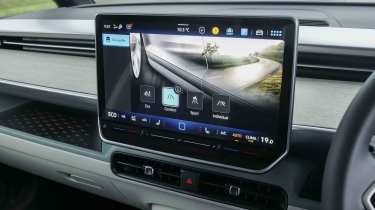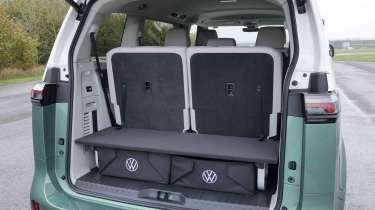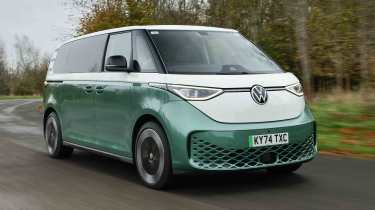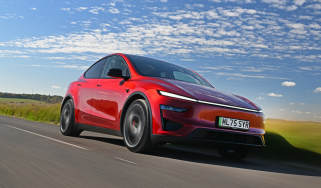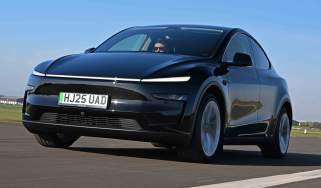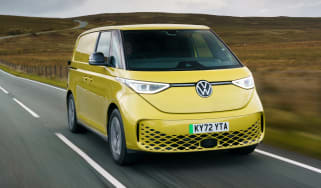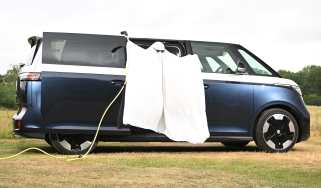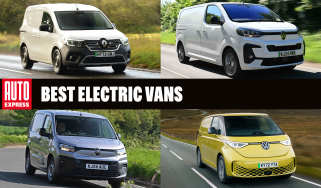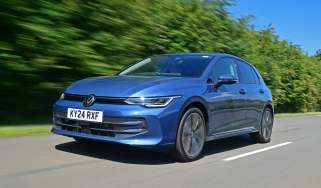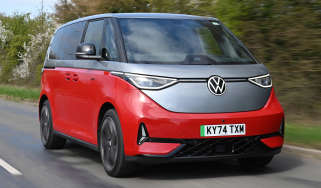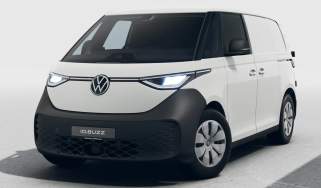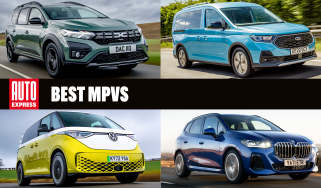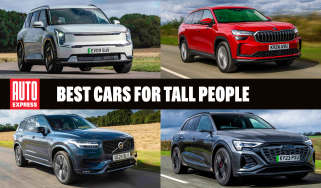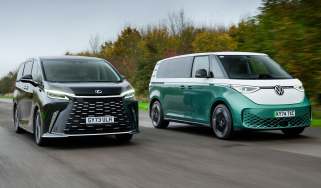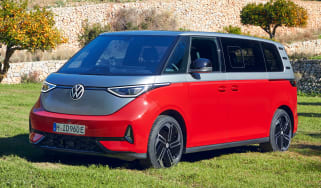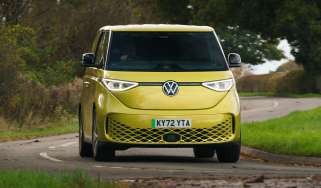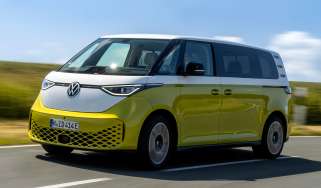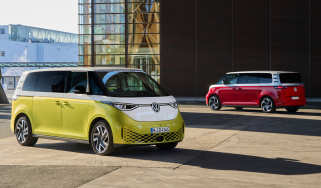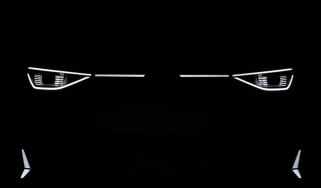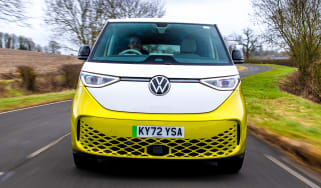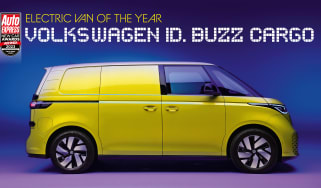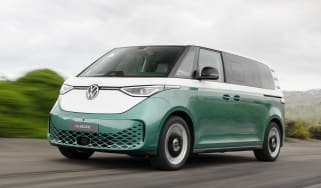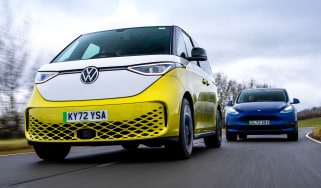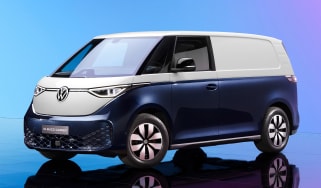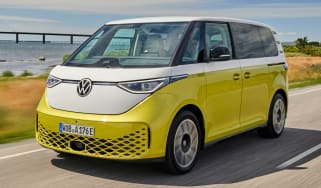Volkswagen ID. Buzz review
While it’s expensive, the ID. Buzz is a great modern take on a VW classic and we’ve really enjoyed using it on our tests

Our opinion on the Volkswagen ID. Buzz
There’s substance to go with the obvious style of the Volkswagen ID. Buzz. It’s a practical electric family MPV that just so happens to emulate the original Type 2 microbus in terms of looks, while its large dimensions mean there’s lots of room inside, especially in long-wheelbase form.
If you can stomach the near-£60k asking price, then it’s a characterful, practical family car that gives reason for buyers to think twice about choosing an SUV to fit the same brief. We’d even go so far as to say that the VW ID. Buzz is the best model currently available in Volkswagen’s electric car line-up.
About the Volkswagen ID. Buzz
There was tremendous hype around the ID. Buzz when it launched in 2022 - so much so that the waiting list was well over a year long. It’s easy to see why, the Volkswagen ID. Buzz might look like a concept brought to life (and it does closely resemble the 2017 concept), but underneath it uses a variant of the MEB platform found under many of VW’s all-electric vehicles.
That means it shares its battery and electric motors with the likes of the ID.3 and ID.4 - which shows in the way it drives. As well as the passenger versions there’s also an ID. Buzz Cargo electric van.
Used - available now

2023 Vauxhall
Mokka Black
19,754 milesManualPetrol1.2L
Cash £17,300
2016 Nissan
Qashqai
77,000 milesManualPetrol1.2L
Cash £5,995
2021 FORD
TRANSIT CONNECT
89,000 milesManualDiesel1.5L
Cash £8,995
2015 Mazda
2
57,000 milesManualPetrol1.5L
Cash £6,521We’ve run both the standard SWB and the LWB models on six-month long-term tests and tested the ID.Buzz head-to-head in the UK against both the Tesla Model Y and the Lexus LM MPV.
Volkswagen ID. Buzz prices and latest deals
With prices starting from just over £59,000, the Volkswagen ID. Buzz is one of the priciest cars that VW sells - only the Touareg SUV and the more conventional Multivan people carrier are more expensive. The base car is the five-seat model in Life trim, while upgrading to six seats adds around £150 to the price.
The seven-seat model is based on a longer-wheelbase body, although a price rise of around £360 to get that is reasonable considering the extra versatility that the LWB version offers – we think it’s well worth the extra outlay. The six and seven-seat versions are available with every trim level of the ID. Buzz.
- ID. Buzz Life - from £59,000
- ID. Buzz Style - from £64,000
- ID. Buzz GTX - from £68,000
You can buy an ID. Buzz now through our Buy A Car service. Spec your car and UK dealers will give you a range of offers to compare. There are also leasing deals and used models to consider.
Performance & driving experience
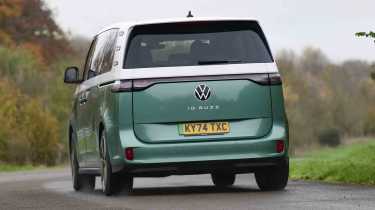
Pros |
|
Cons |
|
The Volkswagen ID. Buzz range has expanded considerably beyond the launch line-up, with the GTX variant and LWB bodystyle being the key additions. It’s a large vehicle but the van-like layout with the high driving position close to the front wheels gives good visibility and a tight turning circle so it generally doesn’t feel as cumbersome as a big SUV. Even considering the size and weight, the electric motors give more than enough performance for an MPV.
Electric motors, 0-60mph acceleration and top speed
A single 282bhp rear-mounted electric motor comes as standard in Life and Style models, while the GTX adds a second electric motor for a total of 335bhp and four-wheel drive.
A 79kWh battery is fitted to the standard ID. Buzz. The LWB has an extra 250mm between the front and rear wheels, making space for a larger 86kWh battery. There’s a 0-62mph time of 7.6 seconds for the base standard ID. Buzz, while the four-wheel-drive GTX manages the sprint in 6.1 seconds.
While that short-wheelbase version weighs-in at a portly 2,454kg, the LWB model adds 189kg, making it slightly slower. In numerical terms, this adds 0.3 seconds to the 0-62mph times for each version, taking them to 7.9 seconds and 6.4 seconds respectively but it’s something that most drivers aren’t going to notice in daily driving. Even in base form, the ID. Buzz feels more than fast and strong enough for an MPV and this is true whether it’s loaded with passengers or not. All versions of the ID. Buzz have a top speed limited to 99mph.
| Model | Power | 0-62mph | Top speed |
| ID. Buzz 79kWh SWB | 282bhp | 7.6s | 99mph |
| ID. Buzz 79kWh GTX SWB | 335bhp | 6.1s | 99mph |
| ID. Buzz 86kWh LWB | 282bhp | 7.9s | 99mph |
| ID. Buzz 86kWh GTX LWB | 335bhp | 6.4s | 99mph |
Town driving, visibility and parking
At nearly two metres wide the ID. Buzz isn’t the easiest car to position on narrow urban streets - width restrictions can be a challenge, too. There are parking sensors all round, including side monitors that can detect obstacles such as bollards next to the car that might be beyond the view of the door mirrors. The auto-braking system applies the brakes if it thinks an impact is imminent and while this can feel a little sudden, it does make the ID. Buzz a hard car to scrape in a car park. Unlike some van-based MPVs, the ID. Buzz doesn’t have wide-angle lower mirrors for extra visibility.
The high-set driving position and huge glass area allow a clear view of your surroundings, although the end of the stubby bonnet is out of view and can be hard to judge. It’s best to assume that the front of the car is where the windscreen ends. Well-weighted steering and a decent turning circle (11.2 metres for standard and 11.8 metres for LWB) for such a large car all helps improve manoeuvrability. There’s strong response from the powertrain, even from a standstill, so keeping pace with traffic is a breeze.
With big 19-inch wheels as standard the ID. Buzz can occasionally crash into big potholes and jiggle over rough surfaces, but Volkswagen has sensibly set up the ID. Buzz for comfort so the suspension does a good job of smoothing out rough surfaces and speedbumps. The GTX model with its 21-inch wheels has a noticeably worse ride around town, however.
Country road driving and handling
Don’t go expecting the traditional sluggish Volkswagen campervan drive from the ID. Buzz. The single-motor’s 282bhp and (more relevant) 560Nm of torque mean the car feels positively rapid for its size and shape.
Acceleration is smooth and the steering is well weighted, but that’s really where the sportiness ends for the big electric VW. The 2.5-tonne kerbweight and soft suspension results in plenty of body lean in the corners if you take them quickly - which is amplified by the high seating.
There’s decent grip overall, but the front tyres will lose traction easily if you’re vigorous with your steering. Even though the ID. Buzz is rear-driven (in single-motor guise), there’s very little sense that power is coming from the rear, unlike many other VW Groups EVs that use this platform. Switching to the LWB with its larger battery doesn’t affect the way the ID. Buzz drives.
The GTX doesn’t feel much sportier either, despite its extra power. The ID. Buzz’s relatively imprecise steering and upright driving position become more of an issue in this supposed performance variant. While it is quicker on paper, the way the GTX accelerates quickly and serenely is very similar to the regular car so it’s difficult to make a case for it.
Motorway driving and long-distance comfort
The ID. Buzz is a really comfortable motorway cruiser. That smooth nose helps it cut through the air without much in the way of wind noise, even if the lack of an engine note means that the rustle of wind is noticeable at motorway speeds, as is the tyre roar.
The ride is at its best at higher speeds, soaking up the bumps with a real quality feel, which further enhances the ID. Buzz’s refinement. Strong crosswinds will tug at the car’s slab sides, but the VW still feels stable enough.
Despite the GTX badge having performance connotations, this isn’t a car that enjoys being pushed along a twisty road. Enter a corner too keenly and the nose will wash wide as the tyres struggle to contain that mass. - Alex Ingram, Chief Reviewer
Range, charging & running costs
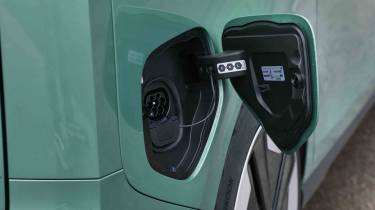
Pros |
|
Cons |
|
The best performing model in the ID. Buzz line-up in terms of range is the long-wheelbase model in entry-level Life trim. Official figures state that it can travel up to 293 miles on a full charge, which is 10 miles further than the standard-wheelbase guise - which gets a 79kWh battery while the LWB gets an 86kWh unit.
Larger wheels trim seven miles from the official range of the Style LWB, at 286 miles, while the standard-length version has a maximum range of 277 miles. As is often the case with the highest-spec EVs in a line-up, the most powerful, four-wheel-drive GTX has the shortest range, covering 282 miles in LWB guise, or 255 miles in its standard form.
Despite the impressive 0.28 drag coefficient, efficiency isn’t a strong point, because when you compare the ID. Buzz with the ID.7, a car that uses similar battery sizes, the latter adds at least 100 miles to these figures.
We only saw 2.5 miles per kWh from our long-term test of the ID. Buzz five-seater but a long-distance European roadtrip and running it over the cold winter months didn’t help. With that in mind, a heat pump is only available as an option that adds around £1,000 to the asking price but we would recommend it.
Our tests of the bigger battery LWB model returned 3.1mi/kWh on average in warmer conditions with a typical indicated range of around 260 miles. The best efficiency we saw on a long run was around 3.4mi/kWh, which got the range up towards 280 miles. We found the indicated range to be very reliable on the whole.
Charging speeds of up to 200kW are available, while a 170kW DC source will get the Volkswagen’s battery from 5-80 per cent capacity in half an hour. You can expect a full charge to take nine hours from an 11kW three-phase AC supply.
| Model | Battery size | Range | Insurance group |
| ID. Buzz 79kWh SWB | 79kWh | 283 miles | 37 |
| ID. Buzz 79kWh GTX SWB | 79kWh | 255 miles | 42 |
| ID. Buzz 86kWh LWB | 86kWh | 293 miles | 37 |
| ID. Buzz 86kWh GTX LWB | 86kWh | 282 miles | 42 |
Insurance groups
Insurance group ratings for the ID. Buzz ranges from 37-42, with the more powerful GTX version laying claim to the highest category. That places the ID. Buzz several groups above Volkswagen’s other van-shaped people-carrier, the Multivan.
Tax
Company car buyers at the 40 per cent rate will see annual outgoings of £359 if they choose an ID. Buzz for the 2025/26 tax year, with its high list price accounting for what are relatively steep rates for an EV. The ID. Buzz is also no longer exempt from road tax (VED), though it’s only £10.
Depreciation
One area where the ID. Buzz has consistently performed very well is residual values. It’s not quite at the peak of its desirability, as it was when first launched, but with retained value figures averaging 60 per cent across the range, it’s the best performer in the VW line-up, and one of the strongest mainstream models from any area of the market.
There’s not much difference through the range with the seven-seat GTX retaining the highest value 61.32 per cent and the five-seat Style retaining 59.4 per cent.
To get an accurate valuation of a specific model, check out our free car valuation tool...
Interior, design & technology
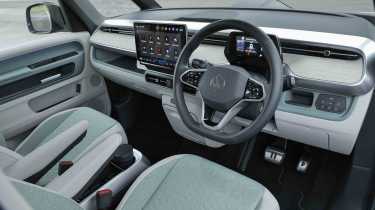
Pros |
|
Cons |
|
The ID.Buzz shares plenty of its design with the 2017 concept car - shown off at Pebble Beach no less. Toned down slightly for production, it also shares some design cues with the rest of VW’s ID electric car range, namely its slender headlights and perforated front bumper. The large VW badge on the front and the V-shaped bonnet are an unmistakable homage to the iconic Type 2 microbus.
The raked windscreen and wipers that neatly tuck down below the bonnet line boost the car's aerodynamics. The sliding side doors move along discreet rails in the sides of the body, while at the back, the vertical rear end design is similar to that of the larger Volkswagen Multivan.
There are single body colours as standard, while the two-tone paint option combines a Candy White roof and bonnet with either Lime Yellow, Starlight Blue, Energetic Orange or Bay Leaf Green for the rest of the bodywork. They certainly emphasise the ID. Buzz’s hippy van heritage, but they also add more than £2,500 to the price tag. It’s a tricky one but we think paying the extra is worth it as the single colour models just don’t look as good.
Life trim comes with 19-inch alloy wheels, while the Style version comes with 20-inch wheels as standard and 21-inch wheels as an option. The latter boosts the ID. Buzz's concept car looks, and in our opinion, doesn't spoil the car's ride too much, either. The four-wheel drive GTX model comes with 21-inch alloy wheels as standard but have firmer sports suspension that further affects the ride.
The jump in price from Life trim to the mid-range Style model is almost £5,000, though it does bring luxuries such as matrix LED headlights, bigger wheels, three-zone climate control, electric rear windows, tinted rear windows and a Harman Kardon sound system, but we don’t think you’d feel short-changed with Life spec.
At the top of the range, the GTX is another £3,600 more than Style, and features more power thanks to a twin electric motor set-up that adds four-wheel drive, even larger wheels, electric front seats with massage, four heated seats and panoramic glass, plus a sportier look and suspension set-up. However, thanks to its extra power, the GTX has a shorter range than the other models in the ID. Buzz line-up.
Interior and dashboard design
The retro exterior looks will turn heads wherever you go, while the interior takes a more modern approach mixed with some of the same appeal. There’s a large touchscreen menu up front, a small digital instrument cluster mounted on the steering column (so it moves with the wheel when you adjust it) and plenty of storage everywhere, while the pale plastics help with the feeling of spaciousness in the cabin.
Materials and build quality
Some of the plastics used in the interior are on the hard side but everything feels durable in line with the utility vehicle remit. There are rubber inserts where you need them that boost the feeling of quality in the cabin.
As with the plastics, the fabric upholstery has a light finish, although there are also dark colours available if you’re concerned about the pale materials showing up dirt. On our tests where we regularly had kids in the car trying not to spill anything on the cream seats was a constant focus. Even after six-months of relatively hard use, however, there were no signs of marking on the fabric, which seemed easy enough to clean.
Leather trim isn’t available, with VW opting for eco-focused recycled materials instead. If you have young children, the darker seat fabric colours will be a safer bet.
Infotainment, sat-nav and stereo
VW’s Discover Pro system includes a 12.9-inch touchscreen that has plenty of features, while 10-colour ambient lighting is fitted as standard. This can be upgraded to a 30-colour system with one of the car’s option packs, which also adds matrix LED headlights (standard on Style models and above) and a panoramic roof with an electrochromatic sun shade - the latter is standard on GTX models. A head up display along with an upgraded sound system come standard on the mid-range Style model.
Recent updates to VW’s multimedia system mean the temperature and volume sliders in the ID. Buzz are now illuminated, so they’re easier to use at night, but still trickier to operate than physical controls.
The big screen has shortcuts at the top and bottom, with an unmarked home button to get you back to the main screen if you need it. The display itself is sharp, although the mapping isn’t the most intuitive system to use. Wireless Apple CarPlay and Android Auto are standard, though, and are displayed well on the screen. Volkswagen’s voice activation software regularly came on unprompted during our long-term test, which was less than ideal.
A useful feature our long-term ID. Buzz had was an ability to conduct bidirectional charging from its battery. Via an outlet between the back seats we could use a coolbox on a camping trip.
Heading back up the M20, another Lime Yellow Buzz drew alongside, a little girl waving from the passenger seat at her car’s twin. You don’t get that in regular models, and that’s one reason that I’m still so fond of the Buzz... - Paul Barker, Editor-in-Chief.
Boot space & practicality
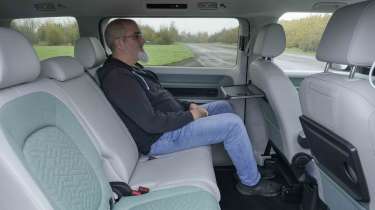
Pros |
|
Cons |
|
It’s rare that you get a car that equally stands up in the design and practicality departments. The ID. Buzz is just that, however, as its looks are matched by its family-friendly approach, as our long term tests of both the five-seat and seven-seat versions have proved.
Handy touches in the name of practicality include a lockable glovebox, a powered bootlid, heated windscreen, sliding doors on both sides, waste bins in the door pockets and some Volkswagen calls a ‘Buzz box’ which is a removable compartment in the centre console.
Dimensions and size
The MPV proportions of the ID. Buzz are evident in its height - it’s taller than many family SUVs despite not offering their useful ground clearance. Still, this does open up unrivalled interior space. When we tested the ID. Buzz against the Model Y we were surprised to see the standard wheelbase VW was actually the shorter car, it looked and felt like a much bigger in the real world.
Dimensions comparison | |||
| Model | Volkswagen ID. Buzz SWB | Tesla Model Y | Vauxhall Vivaro Life Electric (seven-seater) |
| Length | 4,712mm | 4,790mm | 4,959mm |
| Width | 1,985mm | 1,982mm | 1,920mm |
| Height | 1,927mm | 1,624mm | 1,890mm |
| Wheelbase | 2,989mm | 2,890mm | 3,275mm |
| Boot space | 1,121 litres | 890 litres (to the roof) | 603 litres |
Seats & passenger space
In the front of the ID. Buzz you’ll find plenty of headroom and legroom with the latter courtesy of an open space where a centre console would usually go. The seats themselves look a little plain (besides an ‘ID.’ logo in the upper section), but they’re just about supportive enough while being comfortable too. They both feature armrests on the inner side and they’re heated as standard in Life trim.
The second row is a conventional bench arrangement with a 60:40 split fold. This continues to the seven-seater with the possibility of removing the third row entirely when you need to prioritise luggage over passenger capacity.
Space in the second (or middle row for the LWB) is excellent and these seats come with some thoughtful touches like fold-down dinner trays - which we found double as laptop tables and there are two pockets on the backs of each front seat as well. Space in the third row is almost as good - it’s certainly bright and airy back there to keep even adults happy on long journeys.
Access is very easy through the wide-opening side doors and even adults can get into the third row in a dignified manner - unlike in many seven-seat SUVs. The doors themselves are powered and can be a little temperamental if you try to use the handle while they are opening or closing. Purely for practicality though, they’re great.
Boot space
The massive bootlid means you do have to take care to leave enough space behind the ID. Buzz to get it open, especially because it’s electrically-controlled with no sensor to stop it clattering into something. Because it’s so large, it does take a while to glide open on its electric motors.
Once it is open you’re greeted with a huge boot. In five-seat form with the back seats up there’s 1,121 litres of carrying capacity. This drops to 306 litres in the seven-seater with all seats in place where the shape of the space is also very tall and shallow with not a lot of floor area to place items. Fold the third row seats and you have a five-seat vehicle with 1,340 litres of space for luggage.
The shelf arrangement in the rear of the Buzz creates a flat floor when the seats are folded and there's space for the charging cables below that you can always access, even if the rear is fully loaded.
Towing
An electric, retractable tow bar can be added to any version of the ID. Buzz at the cost of £980. Given the big VW’s ability to cater to family trips away, we think it’s an option worth thinking about, though it’s best used for carrying bikes and extra equipment as the towing weight is just 750kg.
“Like on a lot of VW products, I find the ID. Buzz steering wheel buttons annoying. It's so easy to accidentally press the heated steering wheel button with the palm of your hand when holding the wheel normally. At least what is a design flaw in summer becomes a 'feature' in the winter when your hands are cold.” - Steve Walker, Group Web Editor.
Reliability & safety
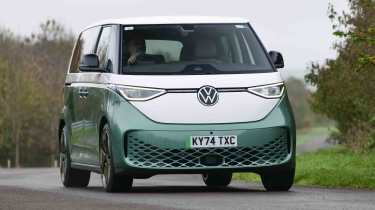
Pros |
|
Cons |
|
Safety kit is first-rate on the Volkswagen ID. Buzz. There are seven airbags (front, side, curtain and central), and autonomous emergency braking with pedestrian and cyclist detection is standard. Adaptive cruise control with speed limiter is also included, as is lane assist, road-sign recognition and a seatbelt alert for every position. Updates for 2024 saw blind-spot monitoring added as standard, rather than being part of the pricey Assistance Package Plus option, because Euro NCAP now tests for a warning system to ensure you don’t open a car door into the path of a cyclist or vehicle approaching from behind. Dynamic matrix LED headlights (which we love on Volkswagen Group cars) only come standard on the Style and GT and can’t be fitted to the base model even as an option.
In the LWB model there are four sets of Isofix child seat attachments in the back – two for each row – while the middle row slides forward to give plenty of room to get a child seat inside.
Euro NCAP retested the ID. Buzz in 2025 where it kept its five-star score overall. It scored 84 per cent for adult occupant protection (eight per cent worse than before) and 85 per cent for child occupant protection (two per cent worse). It also scored 73 per cent for safety assist (down from 90) and 74 per cent for protecting vulnerable road users (14 per cent up from the old score).
Volkswagen as a brand has been dropping quickly down our Driver Power rankings, from 18th out of 29 manufacturers in 2022, to 27th (out of 32) in our best car manufacturer rankings in 2023, 29th in the 2024 and back to 27th in our most recent 2025 poll. One glimmer of hope for ID. Buzz buyers is that the model is sold via VW Commercial Vehicle centres, although a lot of these share sites with the passenger car showrooms.
| Euro NCAP safety ratings | |
| Euro NCAP safety rating | Five stars |
| Adult occupant protection | 84 per cent |
| Child occupant protection | 85 per cent |
| Vulnerable road user protection | 74 per cent |
| Safety assist | 73 per cent |
Buying and owning
Best buy: Volkswagen ID. Buzz Life 7-seat
There’s not much of a price gap to the mid-range Style or even the hotter GTX, but for the purpose of a practical family EV, the ID. Buzz in Life trim and crucially, as a seven-seater is excellent.
Of course, if you don’t need to cart around six other people often then the five or six-seater model will do just fine but those after a seven-seat car then the ID. Buzz is a great option, especially as it’ll comfortably fit adults in the third row - unlike many seven-seat SUVs. The seven-seater also has a better range and a very similar driving experience to the short wheelbase model.
We’d recommend stumping up the extra cash for the two-tone paint options. This is a car that many people will buy with their heart as well as their head, so picking a funky paint to match the looks will definitely help when or if you decide to sell on. The heat pump and the retractable tow bar are other worthwhile options.
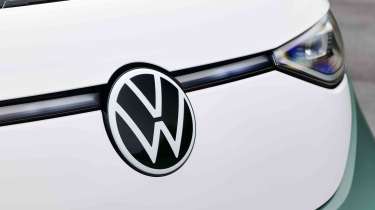
Volkswagen ID. Buzz alternatives
High prices pitch the VW ID. Buzz above equivalent electric van-based MPV rivals to the tune of at least £20,000. The main opponents are a range of closely related models in the shape of the Vauxhall Vivaro Life Electric, Citroen e-SpaceTourer, Peugeot e-Traveller and Toyota Proace Verso. While these models all benefited from a facelift at the end of 2024, none are as stylish as the ID. Buzz, and they can’t match it for range, either.
From the perspective of a desirable and upmarket family car, the ID. Buzz can be ranked against similarly priced electric SUVs, including the BMW iX3, Volvo XC40 Recharge, Ford Mustang Mach-E and Tesla Model Y. However, the ID. Buzz is more practical than any of these, thanks to its flat-folding seats and vast cargo area, while the LWB version adds seven seat without compromising versatility. None of these alternatives can turn quite as many heads as the ID. Buzz, either, and for some that will be enough to justify its entry price.
Deals on alternative cars to the ID. Buzz
Volkswagen ID. Buzz pictures
Frequently Asked Questions
The ID. Buzz costs from just under £60,000 in short wheelbase, five-seat form. The most expensive version is the £68,000 GTX seven-seater.
